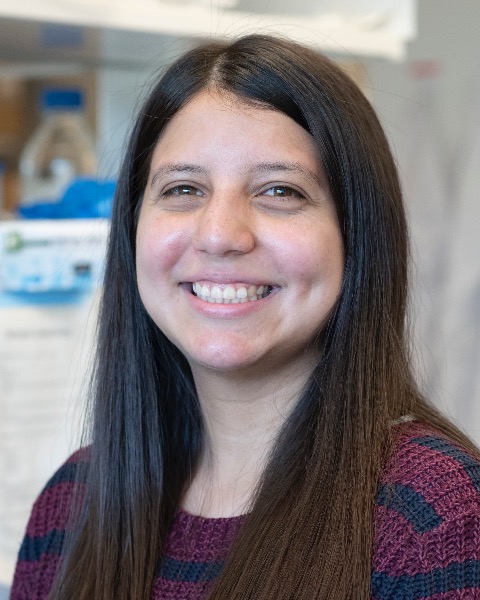Tissue Engineering
Bone Mineral Content Regulates Mesenchymal Stem Cell Phenotype
(K-424) Bone Mineral Content Regulates Mesenchymal Stem Cell Phenotype

Yiwei Yan (she/her/hers)
Undergraduate Researcher
Cornell University, United States
Nicole Sempertegui (she/her/hers)
Graduate Student
Cornell University
Ithaca, New York, United States- CF
Claudia Fischbach
Professor
Cornell University, United States
Presenting Author(s)
Co-Author(s)
Primary Investigator(s)
About 80% of patients with advanced breast cancer develop bone metastases, which lead to significant morbidity and mortality. Disseminated tumor cells initially colonize regions of new bone formation, which are mostly composed of mesenchymal stem cells (MSCs), their osteoblasts derivatives, and the bone matrix. The invasion of tumor cells breaks the balance of bone remodeling when affected osteoblasts are unable to form new bone sufficiently, resulting in osteolytic lesions. These lesions lead to bone pain, weakened bones, high fracture risk, and other potential discomfort and complications. Notably, reduced bone mineral content has been linked with an increased risk for bone metastasis. However, due to a lack of model systems, the crosstalk between MSCs, matrix mineralization, and tumor cell growth remains unclear. To study these connections, our group utilizes bone-mimetic engineered cell culture platforms to provide relevant insights regarding the interactions between MSCs, tumor cells, and bone mineral content by allowing for systematic control over the degree of bone mineralization. To study the hypothesis that reduced mineral content promotes MSC mechanosignaling and increases contractility, key steps in the mechanosignaling cascade as well as myofibroblastic markers will be investigated through immunofluorescent staining after culture on mineralized or control microwells. Overall, investigating how MSCs respond to different matrix mineralization conditions will help better understand how interactions between stromal cells and the bone matrix ultimately impact breast cancer cell outgrowth in bone. A better understanding of these connections may lead to identifying targets for clinical prevention and control of bone metastasis.
Materials and Methods::
The Fischbach lab has developed an engineered model system that recapitulates different degrees of mineralization in bone, which is achieved by the polymer-induced liquid precursor (PILP) method to make polydimethylsiloxane (PDMS) microwells (diameter: 4 mm, height: 250 μm) with mineralized or control collagen. Intrafibrillar mineralization of the collagen matrix was induced by immersing the microwells into a mineral-forming solution for 2 days. Following fabrication, Alizarin Red S staining was used to confirm matrix mineralization. Human bone marrow-derived MSCs (RoosterBio) were cultured on either mineralized or control collagen microwells, and cell morphology was analyzed after 5 and 10 hours of culture in the microwells by staining for DAPI and phalloidin to visualize the nucleus and the cytoskeleton. To examine altered mechanotransduction, MSCs were fixed after culturing for 10 hours in either substrate condition. Mechanosignaling was assessed through immunofluorescent (IF) staining of vinculin and phosphorylated myosin light chain (pMLC), which are key proteins in the focal adhesion cascade. Finally, matrix-dependent differences in contractility were visualized after 4-day culture by alpha-smooth muscle actin (alpha-SMA) expression. Images of the samples were acquired with an epifluorescence microscope and analyzed for differences in positive signal between mineralized or control collagen groups.
Results, Conclusions, and Discussions::
Our results demonstrate successful fabrication and mineralization of PDMS microwells. Positive Alizarin Red S staining showed that the mineralized matrix incorporated calcium, while no calcium was present in control collagen microwells. In addition, brightfield images showed that the fibrillar structure of collagen was present in both conditions. Culture of MSCs on mineralized or control microwells showed differences in cell morphology at both 5 and 10 hours, with MSCs cultured in collagen being significantly more spread when compared to mineralized conditions. To investigate whether the differences in morphology could be attributed to altered mechanosignaling, MSCs were seeded on the substrates for 10 hours and multiple steps in the mechanosignaling cascade were analyzed via immunostaining. Notably, MSCs seeded on control microwells showed that vinculin and pMLC signals co-localized with focal adhesion stress fibers near the cell boundary, whereas mineralized groups presented a diffuse signal distributed throughout the cytoplasm. These results suggest that the presence of mineral in the collagen matrix reduced MSC mechanosignaling. Consistent with increased pMLC activity in collagen substrates, alpha-SMA staining demonstrated that MSCs cultured in collagen substrates had more alpha-SMA expression compared to mineralized conditions, indicating a more contractile phenotype in collagen. Nonetheless, initial trials of alpha-SMA had seeding density issues where the cells were too confluent for the signal to be quantified per individual cells. Collectively, results from mechanosignaling experiments and alpha-SMA expression suggest that reduced mineral content in the bone matrix likely promotes a more contractile phenotype in MSCs. MSCs with a more contractile phenotype can reorient and align collagen fibers, which could favor cancer cell growth and migration. Next steps include improving and refining IF staining techniques for mechanosignaling and contractility analysis with statistical quantification. Finally, in future work, tumor-secreted factors will be incorporated into MSC cultures and mechanotransduction will be similarly analyzed to examine how tumor-conditioned media regulates MSC response to matrix mineralization, and ultimately breast cancer cell growth.
Acknowledgements (Optional): :
References (Optional): :
